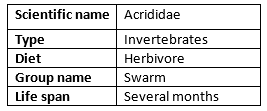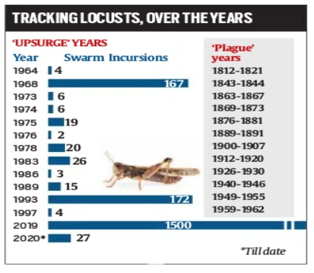

India is gearing up for what could be one of its worst locust invasions in decades. Outbreaks of the insect attack have been reported from Gujarat, Rajasthan, Maharashtra, Madhya Pradesh, Punjab, Haryana and Uttar Pradesh.
Context
India is gearing up for what could be one of its worst locust invasions in decades. Outbreaks of the insect attack have been reported from Gujarat, Rajasthan, Maharashtra, Madhya Pradesh, Punjab, Haryana and Uttar Pradesh.
Background
- The swarms that have been attacking India in the recent past are unique in their strength and nature, but India frequently battles desert locust onslaughts.
- They usually arrive in July-October. In the 2019-20 cropping season, around 3.75 lakh hectares of crops were devoured by locust attacks in India with a loss of over Rs 100 crore.
- Locusts have destroyed over 2 lakh hectares of crops in India since the beginning of May, and threaten another 6 lakh hectares of crop.
- Experts attribute the current deep invasion of locusts to the fact that while rabi crops have been harvested, kharif sowing is yet to begin.
- The low availability of crops is leading the swarms to devour leaves on trees, and vegetable, fruit and cotton crops, and move deeper into India in search of fodder.
- The swarm that is currently attacking India and other nations has its roots in heavy cyclones and rainfall over the past two years, a trend that has been attributed to climate change.
Analysis
What are locusts?
A locust is a special type of short-horned grasshopper. The type recently spied in Africa and Asia has been identified as the desert locust (Schistocerca gregaria).
- The desert locust is of about a dozen species of short-horned grasshoppers that are known to change their behaviour.
- The desert locust typically lives in the Arabian peninsula, in the arid regions of east Africa.
- Desert locusts can fly over 130 km a day, and stay in the air for a long time.
- Desert locusts normally live and breed in semi-arid/desert regions. For laying eggs, they require bare ground, which is rarely found in areas with dense vegetation. The female can lay eggs only in bare sandy soils at 5-10 cm depth.
- Female locusts can lay eggs at least thrice in their lifetime (roughly three to five months), at intervals of 6-11 days. Populationsare said to have the capacity to multiply up to 20-fold in three months.
- Locust plague cycles – defined as a period of two or more consecutive years of widespread breeding, swarm formation and crop destruction – were a recurrent phenomenon throughout the nineteenth century and the first half of the 1900s. The last such cycle was reported in 1959-62.
- They don't attack people or animals, but they're considered the most destructive migratory pest in the world.
The present attack:
- Locust attacks are common, but the present one is the worst India has seen in almost three decades.
- The ones affecting Indian farmlands are desert locusts belonging to the grasshopper family. They are more devastating than other species of locusts.
- Desert locusts have been attacking the Horn of Africa, the Middle East and Pakistan for quite some time now. This is not the first time that India is experiencing a locust invasion either.
- These insects typically attack parts of western India, especially Gujarat and Rajasthan, between June and November.
- However, this year’s attack has been the worst in decades.
What makes locusts swarm?
- Locusts are grasshoppers, different from their peers in their ability to change behaviour, habits and migrate over large distances.
- Grasshoppers, or hoppers, are solitary creatures that don’t live in groups. But if driven by hunger caused by drought or food scarcity, they start to gather together while foraging for food.
- As their population increases in an area, they start becoming “gregarious”.
- In ecology, gregariousness is the tendency of animals to form social groups to hunt or eat together. It tends to induce hoppers to start coordinating their movements and form swarms. Gregarious hoppers are referred to as locusts.
- There are three forms of swarms:
- Small pockets confined to certain areas, called outbreaks
- slightly larger groups, called an upsurge, that are still geographically confined
- mega groups, called plagues, of locusts that are separated by breeding locations but gather together in swarms.
Why are they dangerous?
- A threat to food security: A swarm the size of Paris can eat the same amount of food in a day as half the population of France (based on the calculation that one person eats 2.3 kg of food a day). Among poorer nations, a locust infestation means a serious threat to food security.
- A threat to crops: While the rabi crops, recently harvested, survived the onslaught, the locusts can take a heavy toll on India’s kharif produce if not controlled by the time the harvest season arrives.
- Uncontrolled increase in number: The bigger problem will come once the present swarms breed. An adult female locust lays 80-90 eggs thrice in her three-month life cycle. If left uncontrolled, a swarm can grow exponentially to 40-80 million locusts per square kilometre.
History of damage:
- Locusts have been known throughout history. They’ve been recorded in ancient Egypt through depictions on tombs dating back to 2500 BCE. The Biblerecords swarms from 1450 BCE. They’re also mentioned in the Quran and several other holy books.
They have been recorded in ancient China, Greece, Rome, Syria, and other parts of the world. More recently, in the 19th century, a species of hopper known as the Rocky Mountain locust, now extinct, devastated large parts of the US
- India has not witnessed any full-blown locust cycle since 1962, except for a few surges in 1978 and 1993.
- In 1875, a giant swarm reportedly consisting of over 12 trillion insects, spanning an estimated area of 5.1 lakh sq km blacked out the sky over multiple states, like Colorado and Nebraska.
- They ate everything green, and more, including wool off sheep’s backs, harnesses off horses’ backs, and even the clothes people were wearing. This swarm was the largest gathering of any animal ever recorded.
- To curb the damage, desperate governments started introducing bounties for killed locusts, and farmers dug up pits and burnt them with flamethrowers.
- People even resorted to eating them. Grasshoppers and locusts are said to be among the most nutritious edible insects, with thrice the amount of protein than other kinds of meat.
- The Rocky Mountain locust population slowly started dwindling with changing farming activity. Ploughing, irrigation and mining are thought to have killed thousands of nests of eggs in the soil, bringing down their numbers.
- Within 20 years, this species disappeared off the face of the earth. The Rocky Mountain locust was last seen in 1902 and is now extinct.
- Its extinction is considered to be one of the biggest ecological mysteries.
- Today, North America and Antarctica are the only continents in the world to not have locusts.
How farmers are controlling the attack?
- Today, humans have a distinct advantage in fighting locusts due to deeper knowledge and technology.
- Farmers have switched to crops that can be harvested much before swarming season, and the locusts themselves can be controlled and killed with pesticides.
- Monitoring for locust breeding is essential as it is much easier to destroy eggs than fully grown locusts.
- At present, the primary method of controlling desert locust swarms is through organophosphate chemicals (the prime ingredient in herbicide and pesticide).
- Farmers have been known to beat steel utensils during late afternoons and evenings, and play loud music at night and create wood-fire, to ward off locust swarms from farms, albeit temporarily.
- Additionally, newer technology in the form of serotonin inhibition has shown promise in laboratory settings.
Who keeps an eye on such attacks in India?
- As a result of the 1926-1931/1932 locust plague, India, under the British Raj at the time, began research into the desert locust, beginning in 1931.
- It then led to the establishment, in 1939, of a permanent Locust Warning Organization (LWO).
- Overseen by the Indian Council of Agricultural Research, the LWO monitors locust scenarios over desert areas. It has two headquarters
- one in Faridabad (near New Delhi) for administrative duties
- one in Jodhpur (Rajasthan) for technical operations
Conclusion:
India is scrambling drones, sending teams to spray insecticide and issuing alerts as swarms of locusts descend on its western states. The drones are helping track the voracious insects as they destroy crops, increasing fears over food security and economic malaise in a country already battered by the coronavirus pandemic.



